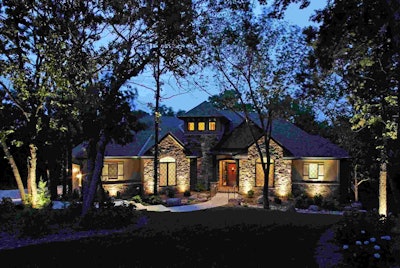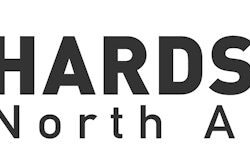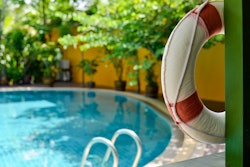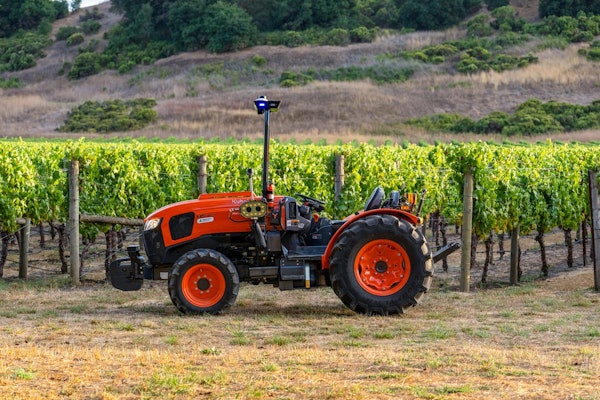 Photo: McKay Landscape Lighting
Photo: McKay Landscape LightingLandscape lighting is growing in popularity as more people are wanting to get the most out of their outdoor living spaces throughout the year.
Part of the reason this demand has grown is thanks to the greater awareness and promotion of professional landscape lighting. Not only do consumers know that they want these lighting systems, but they also have a better idea of how they want their property to look after the project.
“Studies from companies like Houzz and organizations like the National Association of Landscape Professionals (NALP) are also finding that homeowners are now listing outdoor lighting as one of their “most wanted” landscape upgrades,” said Rick Baird, national sales manager – landscape lighting for Vista Professional Outdoor Lighting.
Kristoff Byrd, a category manager on lighting for SiteOne Landscape Supply, credits the introduction of LEDs for smoothing the path for more landscapers to be able to get involved with landscape lighting.
“While still something that needs to be considered, voltage drop is much less of a concern with LED,” Byrd said. “This makes low voltage lighting installations much simpler. That combined with the LED price deflation we have experienced the past few years has made landscape lighting a line of business we are seeing more of our customers getting involved with.”
LED leads the way
Although Byrd says there are still holdouts toward switching to LED, he says the argument that it’s less expensive to use halogen can no longer be made.
 Photo: SiteOne Landscape Supply
Photo: SiteOne Landscape Supply“For instance, on a job with 20 fixtures operating 20W MR16 halogen lamps, contractors pay about $3 a lamp and $400 for a 600W transformer at a total cost of $460,” he said. “Now contractors can purchase 20W equivalent MR16 LEDs for around $16 and a good 150W transformer for $150 for a total spend of $470. Now from a homeowner’s standpoint, take into account the energy costs of operating 400W versus 80W, and LED is a no brainer!”
Baird adds that the size of the system will determine how much homeowners will save each month, with larger ones gathering more savings, but even small systems save a significant amount over time.
Yet many homes still have the older halogen lighting systems that must be accommodated for. For example, McKay Landscape Lighting, based in Omaha, Nebraska, had to find a new manufacturer after receiving the news their current one had discontinued production of the halogen version of the MR16.
“We’re still servicing older halogen jobs, but the new jobs are all LED,” said owner Jerry McKay.
Popular forms of landscape lighting
Because landscape lighting’s main purpose is to provide safety, it’s no surprise that path lighting is the most commonly requested type.
“Most of the consumer landscape lighting kits have always emphasized path lights near walkways and driveways,” Baird said. “And that’s great, but there are so many more beautiful and practical lighting options to consider today.”
 Photo: McKay Landscape Lighting
Photo: McKay Landscape LightingOne option that McKay’s company specializes in that still ensures the ground is well-lit is downlighting.
“You go up a tree, you hang a couple of lights, and you get so much more coverage than a couple of path lights on the ground,” he explained. “All of a sudden, you have a large tree next to the steps; well, you don’t have to use the path lights if you get up and moonlight those trees.”
Tree lighting, in general, continues to remain popular, both with uplighting and downlighting. Uplighting can help draw attention to different focal points and create a beautiful visual.
“Lighting specimen trees and shrubs, architecture, columns, and masonry can also really add a great deal of visual interest and beauty to any landscape,” Baird said.
Some of the popular lighting products that Byrd reports selling includes bullet uplights and under cap/ledge lights.
“Installers are using bullets in places where floodlights and in-ground/well lights were used,” Byrd said. “Under cap/ledge lights enhance hardscapes or patio areas and our suppliers are creating some great products.”
Selecting color temperature
When it comes down to choosing the color temperature, it can be based on the customer’s preference or the particular situation.
However, as a general rule of thumb, most will lean more towards the warmer color temperatures.
“The reasons why cooler (3500K to 5000K) color temperatures are used in healthcare facilities, schools and offices are exactly why they aren’t really popular in landscapes,” Byrd said. “Those color temperatures create alertness due to the crisp settings they project. Landscape lighting generally favors warmer 2700-3000K color temperatures that create a relaxed, inviting environment.”
Yet there are situations where cool color temperatures work well, such as if a white building is being illuminated by a moonlighting fixture through a big tree.
Common mistakes
If you are considering adding on landscape lighting as a service to your business, below are some common mistakes and challenges to be aware of.
While Byrd says that landscape lighting is no longer extremely technical, Baird encourages landscapers to educate themselves on all aspects of professional landscape lighting and to turn to their manufacturers for assistance.
“Some companies that add landscape lighting to their business models don’t fully understand the many great opportunities that accompany selling, designing, installing and maintaining a professional landscape lighting system,” Baird said. “It can be a great profit center for any business that does most of its work in the outdoor environment.”
A common mistake he notices is companies are not comfortable selling a landscape lighting system as a life-changing product but instead focus on price.
 Photo: SiteOne Landscape Supply
Photo: SiteOne Landscape Supply“Because outdoor lighting is such an impactful addition to a homeowner’s property, lighting companies need to realize this is not a “low-bid” business,” Baird said. “By only selling on price, these companies don’t help their customers recognize the perceived and actual value that outdoor lighting adds to a property.”
Additionally, when selling a lighting installation, remember to keep it simple; you are not selling light fixtures but an upgrade to a property.
“Don’t show a homeowner every lighting catalog and let them choose the lights they want to use,” Byrd said. “Always remember that you are selling the light effect, not the lights.”
It’s important to remember that just like anything else in the landscape, the lighting system will need maintenance including replacing damaged fixtures, cut wires and burnt out bulbs.
McKay’s word of advice is to find a dedicated professional focused on that service, as it can sometimes be a challenge for companies adding on the business to find the right personnel who are going to want to go out at night to handle the nighttime adjustments.









